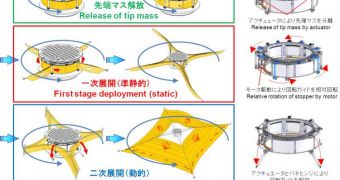Experts at the Japanese Aerospace Exploration Agency (JAXA) announce that their Ikaros technology demonstrator has managed to successfully open its solar sail while in space. The small cosmic machine was launched together with the Akatsuki Venusian orbiter, which is scheduled to reach our neighboring planet this December. But, while all eyes were on the weather satellite – the first to be deployed around other worlds – those managing Ikaros knew that, if they were to be successful, then they could revolutionize propulsion in space.
“This is the first sail ever deployed in space, and if they succeed in using it for solar-sail flight – it’ll still be a few weeks before we know that – it’ll be a milestone,” explains the Executive Director of the Planetary Society, Louid Friedman. This particular organization is in charge with conducting various research into concepts pertaining to future space exploration, and it's also getting ready to construct its own solar sail mission. The reason why these instruments are so appealing is that, once deployed, they only travel by harnessing the energy of sunlight, without needing additional power sources, Wired reports.
Unlike solar panels, which convert incoming sunlight into motion of electrons, which then produce electrical currents, solar sails act just like the average ship sail. It works by harnessing the energy of incoming photons, using them to move forward in the same way common sails use the wind to cut over the waves. “The actual force might be just a few millionths of a g, but because it acts continuously, it allows you to build up large velocity changes over time. That’s where a sail really does its work is long missions,” Friedman adds. JAXA officials add that the full results of the new technology demonstrator will only become visible in a few months or so, after the spacecraft has had a chance to pick up speed.
The new solar sail is made up of a fiber that is only a little bit thicker than spider silk. The 0.0003-inch-thick plastic material is covered in aluminum, and covers an area of no less than 650 square feet. Due to these properties, the sail can capture the momentum of photons slamming into it with great efficiency. “It’s the only way we know – that anybody knows – to ultimately do practical interstellar flight because you don’t have to carry your propellant along with you. Anything else you do, whether it’s nuclear or advanced engines, you’re always carrying propellant and the mass becomes too great,” the Planetary Society executive director concludes.

 14 DAY TRIAL //
14 DAY TRIAL //